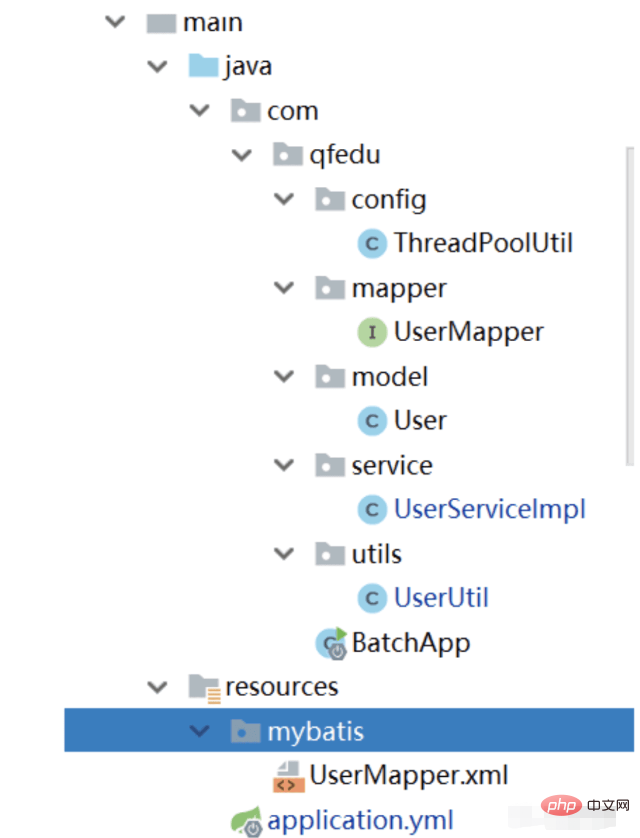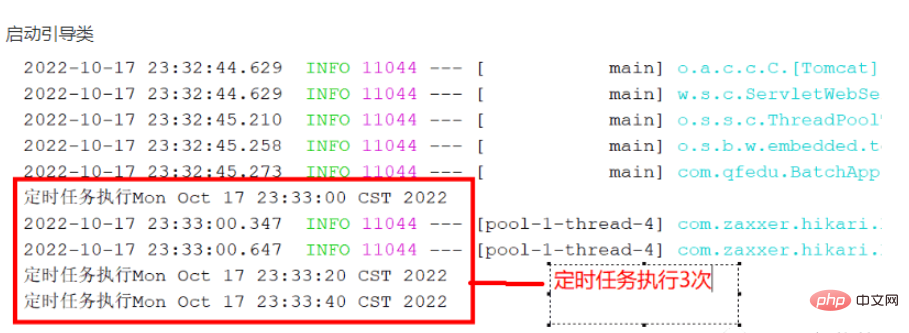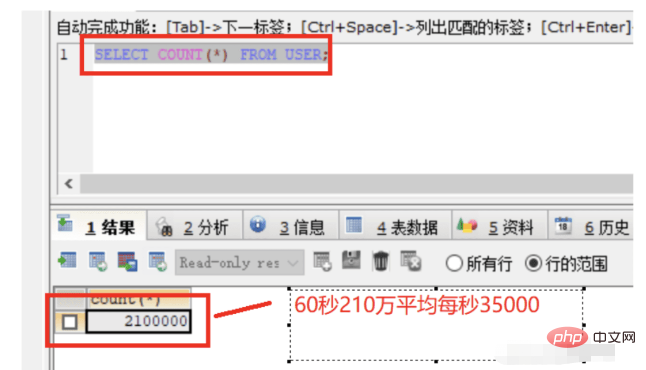How to use springboot+mybatis to quickly insert large amounts of data
1. JDBC implementation plan
Use a for loop to insert data one by one; generate an insertion sql, similar to this insert into user(name,pwd) values('aa','123 '),('cc','123')...
The first solution is to use a for statement to insert in a loop:
The advantage of this solution is that in JDBC PreparedStatement has a pre-compilation function and will be cached after pre-compilation. Afterwards, SQL execution will be faster, and JDBC can enable batch processing. This batch processing execution is very powerful.
The disadvantage is that in many cases our SQL server and application server may not be the same, so network IO must be considered. If network IO is time-consuming, it may slow down SQL execution.
The second option is to generate a SQL for insertion:
The advantage of this option is that there is only one network IO. Even sharding is only a few network IOs, so this solution doesn't spend too much time on network IO.
Of course, this solution also has disadvantages. First, the SQL is too long, and may even require batch processing after sharding; second, the advantages of PreparedStatement pre-compilation cannot be fully utilized, and the SQL must be re-parsed and cannot be reused; third, the final generated SQL is too long, and the database manager must parse it. Such a long SQL also takes time.
We will use the second solution to implement it next.
2. Specific implementation ideas
If we want to increase the insertion efficiency, we definitely cannot insert one by one, we must use foreach batch insertion;
Use multi-threading for asynchronous insertion to improve performance;
We cannot submit multiple inserts at a time. A large number of insert operations will be very time-consuming and cannot be completed in a short time. It can be achieved by using scheduled tasks.
Next let’s talk about how to use code to implement it.
3. Code implementation
This case is mainly implemented based on SpringBoot integrating mybatis.
1. Import dependencies
<parent>
<groupId>org.springframework.boot</groupId>
<artifactId>spring-boot-starter-parent</artifactId>
<version>2.3.4.RELEASE</version>
</parent>
<dependencies>
<dependency>
<groupId>org.springframework.boot</groupId>
<artifactId>spring-boot-starter-web</artifactId>
</dependency>
<dependency>
<groupId>mysql</groupId>
<artifactId>mysql-connector-java</artifactId>
<version>5.1.48</version>
</dependency>
<dependency>
<groupId>org.mybatis.spring.boot</groupId>
<artifactId>mybatis-spring-boot-starter</artifactId>
<version>2.1.0</version>
</dependency>
<dependency>
<groupId>org.projectlombok</groupId>
<artifactId>lombok</artifactId>
</dependency>
<dependency>
<groupId>org.springframework.boot</groupId>
<artifactId>spring-boot-starter-test</artifactId>
</dependency>
</dependencies>2. Create startup class
@SpringBootApplication //引导类核心注解
@EnableScheduling //开启定时任务
public class BatchApplication {
public static void main(String[] args) {
SpringApplication.run(BatchApplication.class,args);
}
}3. Configuration file application.yml
server:
port: 9999 # 指定端口号
spring:
datasource:
driver-class-name: com.mysql.cj.jdbc.Driver
url: jdbc:mysql://localhost:3306/springboot?useUnicode=true&characterEncoding=utf-8&useSSL=false&serverTimezone=UTC
username: root
password: 123
mybatis:
mapper-locations: classpath:mybatis/*.xml #指定mapper映射文件路径
type-aliases-package: com.qfedu.model # 别名4. Create table and entity classes User
Create table:
CREATE TABLE `user` ( `id` INT(11) NOT NULL AUTO_INCREMENT, `username` VARCHAR(30) DEFAULT NULL, `pwd` VARCHAR(20) DEFAULT NULL, `sex` INT(11) DEFAULT NULL, `birthday` DATETIME DEFAULT NULL, PRIMARY KEY (`id`) ) ENGINE=MyISAM DEFAULT CHARSET=utf8
Note: MyISAM efficiency will be faster than INNODB.
User.java
@Data
public class User {
private int id;
private String username;
private String pwd;
private int sex;
private LocalDate birthday;
}5. Persistence layer mapper and mapping files
UserMapper.java
@Mapper
public interface UserMapper {
void insertBatch(@Param("userList") List<User> userList);
}UserMapper.xml
<?xml version="1.0" encoding="UTF-8" ?>
<!DOCTYPE mapper
PUBLIC "-//mybatis.org//DTD Mapper 3.0//EN"
"http://mybatis.org/dtd/mybatis-3-mapper.dtd">
<mapper namespace="com.qfedu.mapper.UserMapper">
<insert id="addList" parameterType="User" >
insert into user (username,pwd,sex,birthday) values
<foreach collection="list" item="item" separator=",">
(#{item.username}, #{item.pwd}, #{item.sex}, #{item.birthday})
</foreach>
</insert>
</mapper>6. Turn on scheduled tasks
SpringBoot integrates scheduled by default. The usage steps are as follows:
In booting Add the @EnableScheduling annotation to the class to enable scheduled tasks;
Add the @Scheduled annotation to the business layer method to define periodic execution of the cron expression.
The threads started in the business layer method can be modified according to the current machine configuration. We have opened 7 threads here, and each thread executes 20 loops and adds 5,000 pieces of data at a time. It should be noted here that when mybatis batch inserts, it is not recommended to exceed 10,000 errors. Because the amount of data is too large, stack memory overflow is prone to occur.
@Component
public class UserServiceImpl {
@Autowired
private UserMapper userMapper;
@Autowired
//线程池
private ThreadPoolExecutor executor;
@Scheduled(cron = "0/20 * * * * ?") //每隔20秒执行一次
public void addList(){
System.out.println("定时器被触发");
long start = System.currentTimeMillis();
for (int i = 0; i < 7; i++) {
Thread thread = new Thread(() -> {
try {
for (int j = 0; j < 20; j++) {
userMapper.addList(UserUtil.getUsers(5000));
}
} catch (Exception e) {
e.printStackTrace();
}
});
try {
executor.execute(thread);
} catch (Exception e) {
System.out.println(e.getMessage());
}
}
}
}7. util to generate objects
We use it to simulate generating data to be inserted. In actual business development, it can be data imported from excel.
public class UserUtil {
private static Random random = new Random();
public static List<User> getUsers(int num){
List<User> users = new ArrayList<>();
for (int i = 0;i<num;i++){
User user = new User();
user.setBirthday(LocalDate.now());
user.setSex(random.nextInt(2));
user.setPwd("123"+random.nextInt(100000));
user.setUsername("batch"+random.nextInt(num));
users.add(user);
}
return users;
}
}8. Thread pool configuration
Thread pool parameters:
corePoolSize number of core threads, the minimum number of threads to be guaranteed in the thread pool;
mainumPoolSize is the maximum number of threads, the maximum number of threads that can run in the thread pool;
keepAliveTime guarantees the survival time, when the thread is idle, how long it will take to recycle the thread;
unit is used in conjunction with keepAliveTime , time unit;
workQueue work queue, used to store tasks before the tasks are executed.
@Configuration
public class ThreadPoolExecutorConfig {
@Bean
public ThreadPoolExecutor threadPoolExecutor() {
//线程池中6个线程,最大8个线程,用于缓存任务的阻塞队列数5个
ThreadPoolExecutor executor = new ThreadPoolExecutor(6, 8, 5, TimeUnit.SECONDS, new ArrayBlockingQueue<>(100));
executor.allowCoreThreadTimeOut(true);//允许超时
return executor;
}
}9. Complete project structure

10. Test


The above is the detailed content of How to use springboot+mybatis to quickly insert large amounts of data. For more information, please follow other related articles on the PHP Chinese website!

Hot AI Tools

Undresser.AI Undress
AI-powered app for creating realistic nude photos

AI Clothes Remover
Online AI tool for removing clothes from photos.

Undress AI Tool
Undress images for free

Clothoff.io
AI clothes remover

Video Face Swap
Swap faces in any video effortlessly with our completely free AI face swap tool!

Hot Article

Hot Tools

Notepad++7.3.1
Easy-to-use and free code editor

SublimeText3 Chinese version
Chinese version, very easy to use

Zend Studio 13.0.1
Powerful PHP integrated development environment

Dreamweaver CS6
Visual web development tools

SublimeText3 Mac version
God-level code editing software (SublimeText3)

Hot Topics
 iBatis vs. MyBatis: Which one is better for you?
Feb 19, 2024 pm 04:38 PM
iBatis vs. MyBatis: Which one is better for you?
Feb 19, 2024 pm 04:38 PM
iBatis vs. MyBatis: Which should you choose? Introduction: With the rapid development of the Java language, many persistence frameworks have emerged. iBatis and MyBatis are two popular persistence frameworks, both of which provide a simple and efficient data access solution. This article will introduce the features and advantages of iBatis and MyBatis, and give some specific code examples to help you choose the appropriate framework. Introduction to iBatis: iBatis is an open source persistence framework
 Comparative analysis of the functions and performance of JPA and MyBatis
Feb 19, 2024 pm 05:43 PM
Comparative analysis of the functions and performance of JPA and MyBatis
Feb 19, 2024 pm 05:43 PM
JPA and MyBatis: Function and Performance Comparative Analysis Introduction: In Java development, the persistence framework plays a very important role. Common persistence frameworks include JPA (JavaPersistenceAPI) and MyBatis. This article will conduct a comparative analysis of the functions and performance of the two frameworks and provide specific code examples. 1. Function comparison: JPA: JPA is part of JavaEE and provides an object-oriented data persistence solution. It is passed annotation or X
 Detailed explanation of the Set tag function in MyBatis dynamic SQL tags
Feb 26, 2024 pm 07:48 PM
Detailed explanation of the Set tag function in MyBatis dynamic SQL tags
Feb 26, 2024 pm 07:48 PM
Interpretation of MyBatis dynamic SQL tags: Detailed explanation of Set tag usage MyBatis is an excellent persistence layer framework. It provides a wealth of dynamic SQL tags and can flexibly construct database operation statements. Among them, the Set tag is used to generate the SET clause in the UPDATE statement, which is very commonly used in update operations. This article will explain in detail the usage of the Set tag in MyBatis and demonstrate its functionality through specific code examples. What is Set tag Set tag is used in MyBati
 Various ways to implement batch deletion operations in MyBatis
Feb 19, 2024 pm 07:31 PM
Various ways to implement batch deletion operations in MyBatis
Feb 19, 2024 pm 07:31 PM
Several ways to implement batch deletion statements in MyBatis require specific code examples. In recent years, due to the increasing amount of data, batch operations have become an important part of database operations. In actual development, we often need to delete records in the database in batches. This article will focus on several ways to implement batch delete statements in MyBatis and provide corresponding code examples. Use the foreach tag to implement batch deletion. MyBatis provides the foreach tag, which can easily traverse a set.
 Detailed explanation of how to use MyBatis batch delete statements
Feb 20, 2024 am 08:31 AM
Detailed explanation of how to use MyBatis batch delete statements
Feb 20, 2024 am 08:31 AM
Detailed explanation of how to use MyBatis batch delete statements requires specific code examples. Introduction: MyBatis is an excellent persistence layer framework that provides rich SQL operation functions. In actual project development, we often encounter situations where data needs to be deleted in batches. This article will introduce in detail how to use MyBatis batch delete statements, and attach specific code examples. Usage scenario: When deleting a large amount of data in the database, it is inefficient to execute the delete statements one by one. At this point, you can use the batch deletion function of MyBatis
 Detailed explanation of MyBatis cache mechanism: understand the cache storage principle in one article
Feb 23, 2024 pm 04:09 PM
Detailed explanation of MyBatis cache mechanism: understand the cache storage principle in one article
Feb 23, 2024 pm 04:09 PM
Detailed explanation of MyBatis caching mechanism: One article to understand the principle of cache storage Introduction When using MyBatis for database access, caching is a very important mechanism, which can effectively reduce access to the database and improve system performance. This article will introduce the caching mechanism of MyBatis in detail, including cache classification, storage principles and specific code examples. 1. Cache classification MyBatis cache is mainly divided into two types: first-level cache and second-level cache. The first-level cache is a SqlSession-level cache. When
 Detailed explanation of MyBatis first-level cache: How to improve data access efficiency?
Feb 23, 2024 pm 08:13 PM
Detailed explanation of MyBatis first-level cache: How to improve data access efficiency?
Feb 23, 2024 pm 08:13 PM
Detailed explanation of MyBatis first-level cache: How to improve data access efficiency? During the development process, efficient data access has always been one of the focuses of programmers. For persistence layer frameworks like MyBatis, caching is one of the key methods to improve data access efficiency. MyBatis provides two caching mechanisms: first-level cache and second-level cache. The first-level cache is enabled by default. This article will introduce the mechanism of MyBatis first-level cache in detail and provide specific code examples to help readers better understand
 MyBatis Generator configuration parameter interpretation and best practices
Feb 23, 2024 am 09:51 AM
MyBatis Generator configuration parameter interpretation and best practices
Feb 23, 2024 am 09:51 AM
MyBatisGenerator is a code generation tool officially provided by MyBatis, which can help developers quickly generate JavaBeans, Mapper interfaces and XML mapping files that conform to the database table structure. In the process of using MyBatisGenerator for code generation, the setting of configuration parameters is crucial. This article will start from the perspective of configuration parameters and deeply explore the functions of MyBatisGenerator.






